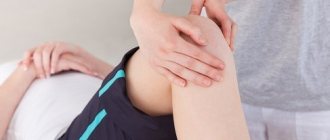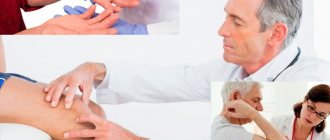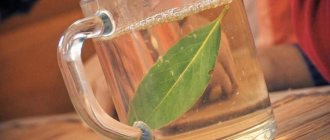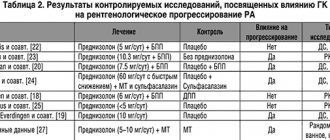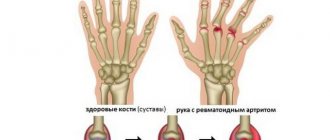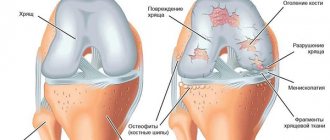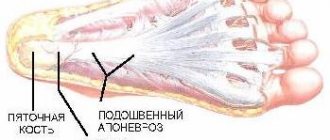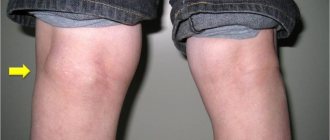The disease causes destruction of the synovial membrane of the joint, cartilage, and bone. In its chronic form, the disease causes pain for many years and interferes with leading a full life. Over time, the degree of damage to the knee joint will only increase, so treatment should begin as early as possible.
Symptoms of rheumatoid arthritis of the knee joint
Characteristic manifestations of the disease can be detected without the use of special diagnostic equipment:
- decreased mobility of the knee, which manifests itself at the initial stage of the disease only after an overnight rest;
- sharp or aching pain that intensifies with movement; may spread to the entire leg;
- inflammation, signs of which are swelling of the knee, local changes in body temperature;
- effusion in the affected area;
- fever;
- increased fatigue.
As the disease progresses, the symptoms of rheumatoid arthrosis of the knee joint will intensify, and its deformation will be visible even to a non-specialist. Start treatment without waiting for the problem to become disabling! At the initial stage, the destruction of the knee can still be stopped.
Causes of rheumatoid arthritis of the knee joint
Absolutely anyone can get sick, regardless of gender, age, or lifestyle. Rheumatoid arthritis is caused by a combination of several factors:
- hormonal disorders - this is why women of puberty usually become ill;
- injuries, as well as unsuccessful operations or incorrect rehabilitation after them;
- hypothermia of the body;
- smoking;
- infectious diseases;
- allergy.
The bulk of officially registered patients are men and women aged 25 to 55 years.
Read also
Joint pain and swelling
Symptoms of joint pain and swelling can vary from person to person and depend on which joints are affected.
Regardless of the cause, joint pain and swelling can be significant... Read more
Fibromyalgia
“What is well recognized is well treated,” Hippocrates once said long ago and he was absolutely right, because only by understanding the cause and nature of the disorder in the human body can one successfully get rid of...
More details
Mesh pattern on the body
A reticular pattern on the body is characterized by the appearance of skin coloring in the form of a network due to vascular damage. This phenomenon is described as a reticulated bluish discoloration against a background of pale skin. Mesh pattern...
More details
Bursitis
Bursitis is a painful condition that affects small fluid-filled sacs—bursae—that cushion the movement of bones, tendons and muscles near joints. Bursitis occurs when...
More details
Change in skin color of hands and feet
A change in the color of the skin of the extremities with a decrease in temperature, or spontaneously, is characteristic of the so-called Raynaud’s phenomenon, which occurs in such rheumatological diseases as: Systemic…
More details
Stages of rheumatoid arthritis of the knee joint
The disease develops gradually, so at first a person does not attach much importance to minor health problems. The course of the disease can be divided into 2 stages:
- Initial, when the victim is plagued by minor pain, and in the morning the knee joint is inactive. After a few hours, the victim forgets about the illness - exactly until its new manifestations.
- Transition to the stage of rheumatoid polyarthritis, which usually manifests itself symmetrically on the left and right limbs. The pain does not stop, and difficulties with movement appear.
Arthritis in severe cases is no longer just mild pain or inflammation. Destruction can affect muscles, affect the liver, heart, lungs and other internal organs. In this case, the patient’s life is at risk. The risk of disability increases.
Symptoms: how does arthritis differ from arthrosis in sensations?
The difference between arthritis and arthrosis is that arthritis begins with joint swelling, erythema (redness and warmth of the skin) and sharp pain that is not related to the intensity of movement. Painful sensations may even intensify at night (while arthrosis “subsides” after rest). There is often no crunch in arthritis. The pathological condition is usually provoked by stress, fatigue, colds, sore throat, cystitis and more. The course of an acute episode may be accompanied by:
- increased temperature;
- fever;
- enlargement of the joint due to swelling;
- loss of strength, increased fatigue;
- weight loss.
- Depending on the etiology:
- conjunctivitis;
- pain in the urinary tract;
- negative symptoms from organs with an active blood supply (heart, lungs, kidneys, liver).
The first sign of arthrosis is usually muscle discomfort, tension, and the appearance of a dull crunching sound in the joints. Morning stiffness and other signs may appear much later. Symptoms develop gradually, the disease is characterized by a sluggish nature - this is the main way arthrosis differs from arthritis. As it progresses, the following appears:
- reduction in range of motion;
- changing the contours of the joint;
- pain that gets worse after exercise.
Redness of the skin and paroxysmal character are not typical for arthrosis unless it is complicated by arthritis.
The nature of sensations during arthritis and arthrosis may be similar, but their mechanisms differ significantly. Thus, the classic symptoms of arthritis (swelling, pain, redness of the skin) are formed due to synovial effusion produced by the joint membrane during inflammation. Symptoms of arthritis are associated with mechanical damage to the articular surface and bone, the formation of bone spurs to distribute the decompensated load.
Localization: what is the difference between arthritis and arthrosis?
Both diseases can affect any joint, but in most cases the location of the pathology can indirectly indicate its nature. So, for example, arthritis has a so-called “affected joints” and “excluded joints” - depending on the prevalence of the disease.
Arthritis primarily affects:
- wrist and metacarpophalangeal joints;
- proximal interphalangeal joints;
- knee and ankle;
- metatarsophalangeal (in particular, the joints of the big toes);
- elbow joints.
The lesions can be either symmetrical (rheumatoid arthritis) or asymmetrical (psoriatic and other types).
Arthrosis selects load-bearing joints, which anatomically experience greater load. These include:
- knee:
- metacarpophalangeal joints of the thumbs;
- distal finger joints;
- hip;
- ankle;
- intervertebral.
Diagnosis of rheumatoid arthritis of the knee joint
The doctor, in addition to visually examining the patient and interviewing him, uses hardware diagnostic tools for rheumatoid arthritis. First of all, a blood test is performed to help detect signs of the disease, which include:
- increase in ESR;
- low hemoglobin levels and a decrease in the number of red blood cells (anemia);
- The level of C-reactive protein in the blood is higher than normal.
In addition to blood composition, the following are examined:
- X-ray of the knee, as well as the results of an ultrasound examination (ultrasound).
- Intra-articular fluid. If the diagnosis is confirmed, it has a reduced density, low transparency, and a high number of individual blood cells - neutrophils, leukocytes and others.
- Urine for the presence of protein.
- Test for the presence of antibodies to immunoglobulins. With a 70% chance of rheumatism it will be positive.
- Serum creatinine and urea levels.
If several symptoms of the disease have been identified, the doctor may prescribe an additional examination, based on the results of which treatment is prescribed. The first signs that attract attention are:
- nodules characteristic of rheumatism;
- positive result of rheumatoid testing;
- manifestation of arthritis in other joints (hands, etc.);
- joint deformation - visible visually or using x-ray examination;
- stiffness of movements.
Diagnostics
The diagnosis is made after interviewing the patient and examining the condition of the joints.
Additional examination:
- General blood test - characterized by a decrease in hemoglobin levels and an acceleration of ESR.
- rheumatoid factor, antibodies to cyclic cetrillinated peptide (ACCP).
- biochemical indicators - AST, ALT, urea, creatinine. They are necessary to assess the safety of prescribing therapy and its further tolerability.
- radiography of hands and feet. Erosive changes characteristic of rheumatoid arthritis develop primarily in these joints, but not earlier than 6 months. To monitor the condition of the lungs and heart, a chest X-ray is taken, and for special indications, a computed tomography scan of the lungs is done. MRI or ultrasound - especially if the disease is at an early stage, when external deformation of the joints is not so noticeable, and it is important to track minor changes.
Of course, the sooner the patient seeks medical help, the more favorable the prognosis for the course of the disease. If you notice joint problems in yourself or your loved ones, do not delay contacting a specialist. This is a serious disease that causes irreversible changes, i.e. The longer a patient delays seeing a doctor, the more damage he causes to his own quality of life, even after a course of treatment in the future.
Treatment of rheumatoid arthritis of the knee joint
The methods used to combat the disease are divided into non-drug and drug-based. Surgery (surgery) is used in extreme cases.
Non-drug treatments for rheumatoid arthritis of the knee:
- Pharmacopuncture. Designed to relieve inflammation and provide nutrition to the damaged joint.
- Shock wave therapy, which serves to restore normal blood supply. Returns the ability to bend the leg at the knee.
- Vacuum therapy is a type of massage based on the organization of low pressure zones in a certain area.
- Magnetotherapy. It has an analgesic and anti-inflammatory effect on affected joints.
- Laser therapy. Increases local immunity, has anti-inflammatory and sedative effects, improves blood circulation.
In contrast, some medications, in addition to the obvious effect (relieving pain, inflammation, etc.), may also have side effects:
- non-steroidal anti-inflammatory drugs;
- basic medications, the use of which begins immediately after diagnosis and can continue throughout life;
- hormonal agents.
How to treat rheumatoid arthritis of the knee joint and in what ratio to use Eastern and Western methods, the doctor must determine individually.
Arthritis and arthrosis (joint diseases)
Arthritis
Arthritis is usually called inflammation of a joint (the name “arthritis” comes from the Greek word arthron, which means “joint”). Arthritis can be of traumatic, infectious and dystrophic origin.
Damage to one (arthritis) or several joints (polyarthritis) can be a symptom of other diseases. Arthritis often occurs due to repeated minor injuries, open or closed injuries to the joints. Arthritis can develop with frequent physical overexertion and hypothermia. Various infections (for example, intestinal or urinary) can also cause arthritis, called reactive arthritis. Rheumatoid arthritis also occurs, in which progressive inflammation of several joints (most often small) occurs, with the limbs affected symmetrically. Older people often suffer from this. The cause of arthritis can also be a metabolic disorder, as a result of which the nutrition of the joints deteriorates.
Arthritis in its various forms can be characterized by different combinations of symptoms. Arthritis usually causes swelling in the affected joints. In the initial stages of the disease, pain can occur both during movement and physical activity, and at certain times of the day (for example, at night or in the form of morning stiffness). If arthritis becomes chronic, the pain may become constant. In addition, the inflamed joint usually becomes red, swollen and even deformed, its function is impaired, and in severe cases of arthritis it becomes completely immobile.
Types of Arthritis
Depending on the nature of the lesion, the main types of arthritis are divided into two classes: inflammatory arthritis and degenerative arthritis.
Inflammatory arthritis includes:
- infectious arthritis
- rheumatoid arthritis
- gout
- reactive arthritis
They are associated with inflammation of the synovium - a thin film of connective tissue lining the joint from the inside.
Degenerative arthritis includes:
- osteoarthritis
- traumatic arthritis
These diseases are associated with damage to the articular cartilage that covers the ends of bones where they articulate.
Causes of arthritis
Causes of arthritis: bacterial, viral or fungal infection, injury, allergies, metabolic disorders, diseases of the nervous system, lack of vitamins. Typically, infection enters the joints through the circulatory system from another part of the body; this can occur during injury or surgery.
Arthritis symptoms
Arthritis is characterized by pain in the joint, especially when moving, there are often restrictions on its mobility, swelling, changes in shape, sometimes the skin over the joint turns red and fever appears. Symptoms of infectious arthritis are redness, swelling, pain when pressed, and common symptoms of an infectious disease are often observed - fever, chills, pain throughout the body. There is arthritis of one joint (monoarthritis) and many (polyarthritis). Arthritis can begin immediately and be accompanied by severe pain in the joint (acute arthritis) or develop gradually (chronic arthritis). Arthritis can occur suddenly or develop gradually. Some people experience a sharp, aching or dull pain. This pain is comparable to toothache. Movement in this joint is usually impaired, although stiffness is sometimes observed.
Arthritis treatment
Treatment for arthritis depends on the form of the disease. First of all, it is necessary to eliminate its underlying cause (excessive exercise, poor diet, alcohol abuse). Treatment of arthritis involves taking antibiotics; non-steroidal anti-inflammatory drugs administered intra-articularly are also used. When treating arthritis, specialists also pay great attention to physiotherapeutic procedures and therapeutic exercises necessary to maintain joint mobility and preserve muscle mass.
Arthrosis
What is the difference between arthrosis and arthritis?
Arthrosis (from the Greek arthron - joint), a chronic metabolic disease of the joints, accompanied by changes in the articulating surfaces of the bones. The more correct name for arthrosis is osteoarthritis. The main symptoms of arthrosis: severe pain in the joint, decreased joint mobility. If arthrosis is neglected, joint immobility occurs. The main difference between arthrosis and arthritis: with arthrosis, the main destructive activity is performed not by inflammatory, but by degenerative processes in the articular cartilage. Arthrosis is not an inflammatory disease and therefore has nothing in common with arthritis or chronic polyarthritis, in which joint inflammation is based on a reactive pathological change in the joint fluid. The same can be said about acute arthritis - inflammation of the joints caused by various infectious agents. Characteristic symptoms of arthrosis are pain during exertion, subsiding with rest, limited mobility and crunching in the joint, muscle tension in the joint area, possible periodic swelling, gradual deformation of the joint.
Unlike arthritis, arthrosis is a joint disease accompanied by the destruction of cartilage, and inflammation occurs later and may not be permanent.
Arthrosis causes pathological changes in joint tissue, and the causes of the disease are still not fully understood. Arthrosis develops under the influence of various genetic (arthrosis most often affects women, as well as people with congenital diseases of bones and joints) and acquired (old age, excess weight, previous joint surgeries) factors. Osteoarthritis can also occur as a result of excessive stress on the joints or their injuries. It is customary to distinguish between primary and secondary arthrosis. Primary arthrosis is the result of a disruption in the regeneration processes of cartilage cells, which can occur due to poor blood supply and nutrition of joint tissues. It is believed that secondary arthrosis develops in an already affected joint, but it is difficult to draw a clear boundary between these two forms.
In the initial stages, arthrosis manifests itself in the form of unpleasant sensations and crunching when bending the joints. When arthrosis begins to progress, pain appears during movement and physical activity, intensifying towards the end of the day (it usually subsides during the night, and a person suffering from arthrosis may not pay attention to the disease for a long time). In the later stages of arthrosis, the mobility of the joints is completely impaired, and pain torments the person more and more often. Arthrosis is very dangerous, and if degenerative tissue changes have gone too far, the doctor will not be able to restore the joint. Usually it is only possible to slow down the progression of the disease, relieve inflammation (through the use of non-steroidal anti-inflammatory drugs) and reduce pain. To prevent arthrosis from leading to disability, the patient should try to reduce the load on the affected joint and get rid of excess weight, which is facilitated by physical therapy and physiotherapeutic procedures. Severe arthrosis may require surgical intervention.
Classification of arthrosis
- Primary arthrosis accounts for approximately 40-50% of all cases of arthrosis. In this case, the disease occurs on a previously healthy joint, and its cause is not damage to the joint, but, for example, heavy physical work.
- Secondary arthrosis accounts for approximately 50-60% of cases. In this case, the joint susceptible to arthrosis was deformed even before the disease - for example, as a result of injury.
Arthrosis affects 10 to 15% of the world's population. With age, the risk of arthrosis increases significantly. Symptoms of arthrosis are often detected as early as 30-40 years of age. 27% of people over 50 years old suffer from arthrosis. And after 60 years, almost everyone suffers from this disease. The incidence of arthrosis is the same among men and women. An exception is arthrosis of the interphalangeal joints - this type of arthrosis occurs most often in women.
The causes and nature of the disease may vary. Arthrosis can develop due to rheumatic conditions. This applies to people with chronic rheumatism. Diseases sometimes occur in whole “sets”: arthrosis is accompanied by rheumatism, varicose veins with thrombosis, vascular sclerosis, stroke, etc. Everything in the body is interconnected. Arthrosis can also be an autoimmune disease. This means that the immune system, whose purpose is to protect you from viruses and bacteria, suddenly begins to attack healthy cells. The mystery of why the body begins to attack itself has not yet been solved.
But still, most often arthrosis is a sign of rheumatoid arthritis, and represents destructive changes in cartilage and bone tissue that occur with age as a result of natural aging. Statistics are also eloquent. Upon reaching 60-70 years of age, the disease arthrosis is diagnosed in 60-70% of people. The words “arthrosis” and arthritis are similar only phonetically, but the causes are completely different and, accordingly, the treatment as well. When highlighting the differences between arthrosis and arthritis, it is important to realize the different direction in which the destructive and deforming process occurs. If you have arthrosis, then the metabolism in the joint is disrupted, its elasticity is lost, the cartilage becomes thinner and every movement causes pain. If you have arthritis, then your immune system has attacked the joint, your body works against its tissue and this causes inflammation, pain and changes that are deforming in nature. Understanding this is important because it determines treatment. While autoimmune processes will be suppressed in arthritis, mechanical restoration of the joint is the main goal for treating patients with arthrosis.
The first blow is taken by the knee joints, elbow joints, and arms. Thus, arthrosis of the knee joint is the most common. Over time, deforming arthrosis occurs, the joints begin to deform, and due to curvature, the affected areas can take on bizarre shapes. There are, in particular, terms such as “swan neck”, “button loop”. If a person has arthrosis deformans and the fingers are affected, then in appearance they may become shorter.
Deforming arthrosis is a disease of our time; a sedentary lifestyle has led us to it. Nature destined us to live differently, but by automating processes, man “earned” a lot of sores with which people pay for all the benefits they receive. Deforming arthrosis usually affects the supporting joints. Osteoarthritis of the knee joint is explainable because its peculiarity, unlike other joints, is the heavy loads it bears. Nature did not take much care in feeding such overworked places. And since the cartilage of the knee joint does not have its own vessels, it can atrophy as a result of aging or under the influence of infections or injuries.
Which joints are affected by arthrosis?
The most common diseases are arthrosis of the joints of the lower half of the body (hip, knee, first metatarsophalangeal). Most often, osteoarthritis affects the knee (gonarthrosis) and hip (coxarthrosis) joints. One of the earliest symptoms of arthrosis is pain in the knee joints. At the beginning of the disease, it is practically absent at rest, but appears when the joint is loaded. For arthrosis of the knee joints, massage of the lower extremities can be useful, but direct impact on the diseased joint should be avoided, as this can increase the inflammatory reaction in it.
In the hands, the joints of the phalanges of the fingers are most often affected by arthrosis. Arthrosis usually occurs first on one joint, and then on the second - symmetrical to the first.
Arthrosis of the spine
Ankylosing spondylosis (Bechterew's disease) leads to limitation of the motor capabilities of the spine - due to the connection, i.e. fusion of some joints. The results of an X-ray examination reveal that the spine, subject to arthrosis, looks like a bamboo stick.
There are five forms of spinal arthrosis:
- Central - only the spine is susceptible to arthrosis
- Arthrosis affects not only the spine, but also the shoulder or hip joints.
- Peripheral - the spine and peripheral joints are susceptible to arthrosis
- Scandinavian - arthrosis damage occurs in the spine and small joints of the hands and feet
- Ankylosing spondylitis with extra-articular manifestations: damage to the eyes, cardiovascular system, kidneys, lungs in the form of fibrosis.
An assessment of how much arthrosis has damaged the spine, or more precisely, how much it has limited mobility, is carried out using the following tests:
It is necessary to tilt your torso forward as far as possible without bending your knees. The distance to the floor in the absence of arthrosis is within 5 millimeters.
You need to stand with your back to the wall and press your heels, buttocks and the back of your head against it. Most often, patients with arthrosis cannot touch the back of their heads.
You need to stand up straight, without bending your spine, and then try to reach the shoulder joint with your ear.
Patients with arthrosis cannot do this.
Causes of arthrosis
Arthrosis can occur as a result of intoxication, infectious diseases (for example, typhus, syphilis, etc.). Arthrosis can also occur due to joint injuries (fracture of the articular ends of bones, damage to articular cartilage), with significant functional overload of the joint (for example, ballet dancers, loaders and etc.). Colds are of known importance (for example, arthrosis in workers in hot shops).
Symptoms of arthrosis
The basis of the disease is a malnutrition of the articular (epiphyseal) ends of the bones. Due to changes in patency or damage to the vessels supplying the bone, aseptic necrosis occurs, aggravating lesions in the joint. Thus, arthrosis is progressive. Initially, painful changes appear in the inner (so-called synovial) membrane of the joint capsule, then they capture the cartilage covering the articular surfaces of the articulating bones; the cartilage gradually breaks down, exposing the bone; The bone tissue is thinned out in places, thickened in places, bone spike-like outgrowths are formed - a picture of deforming arthrosis develops. More often, arthrosis develops in the hip, knee and first metatarsophalangeal joints. Typically, middle-aged and elderly people suffer from arthrosis. Arthrosis is manifested by pain that appears gradually, occurs periodically, worsens after sudden physical exertion or, conversely, after a long period of rest. Due to pain, mobility in the joint is limited. Arthrosis is accompanied by inflammation of the tissues surrounding the joint and nerve trunks; joint function also suffers due to protective muscle tension.
Treatment of arthrosis
Treatment of arthrosis is outpatient and in sanatorium-resort conditions. Prescribe painkillers, hormonal drugs (adrenocorticotropic), physiotherapy (thermal procedures, ultrasound), therapeutic exercises, massage. In severe cases, surgery (arthrodesis, arthroplasty) is used to treat arthrosis. If the wear and tear of cartilage has not yet progressed too far, medications containing glucosamine sulfate, a natural substance obtained from the shells of marine animals, can help. It has a positive effect on cartilage metabolism and improves joint mobility.
Proper nutrition for rheumatoid arthritis of the knee joint
The diet for rheumatoid arthritis is based on several principles:
- you need to eat in small portions, at least 4 times a day;
- You should avoid cold dishes and limit the consumption of highly heated foods;
- it is necessary to reduce salt intake to the amount indicated by the doctor;
- drink about 2 liters of liquid per day.
Healthy foods that should form the basis of your diet:
- fruits and vegetables;
- bread - rye or bran;
- cereals;
- fresh greens are a source of vitamin C, iron, calcium;
- lean meat;
- sea fish;
- dairy products;
- green tea, natural juices.
You should limit yourself to sour, salty, spicy foods, coffee and alcohol, and avoid fatty foods.
Features of treatment
Therapy includes the use of medications and auxiliary procedures. For rheumatoid arthritis, anti-inflammatory and antibacterial drugs and a special diet (foods high in antioxidants and vitamin E) are prescribed. Rheumatoid arthritis requires the use of anti-inflammatory drugs and drugs that correct the functioning of the immune system. For both diseases, physiotherapy, treatment at resorts, massage, exercise therapy and the use of some folk remedies under the supervision of a doctor are indicated. In particularly difficult cases, surgical methods are used.
Gymnastics for rheumatoid arthritis of the knee
Physical exercise will help keep muscles toned and maintain joint mobility. The intensity of the exercises is determined by the doctor, who can supplement the list of basic exercises:
- lying on your back, bend your leg at the knee joint, without lifting the sole off the floor;
- bending your knees, make rotational movements, as when riding a bicycle;
- bending your knees, spread them apart and bring them back;
- swing your legs without bending them at the knee (lying and standing);
- make circular movements with the leg bent at the knee;
- spreading straight legs to the sides in a lying position.
When prescribing gymnastics for rheumatoid arthritis of the knee, the doctor takes into account the presence of concomitant diseases and the degree of damage to the joint.
